Cafe Scene
from Requiem performance in 'De Lantaren' in Rotterdam, 1971.
Masked actors reproducing in real time events recorded in high speed film
on the backprojection screen behind them. The conversation was recorded
during filming.
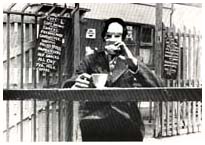 There's trouble down at our place today, 2 doors down you know. They've
got a meter in the hall, the gas is off in my room see. All those buggars
have been thieving the money of the gas meters so they've turned it off.
They can't get into my room I've got a yale lock on and I told them I
wasn't going to do it no more so I said the easy way was to come and cut
off the gas and not I know how they do it an all you know where they lock
it the little thing that tells you the meters, how much you got, well
they lift that out, unscrew that put it back see so no gas can go even
if you put the money you've got to phone the gas board to do it, he told
me, he says, I could do it, I could do it with me key like if he gave
me a key, but I haven't got a key. Now he asked me, he says, if you got
a key and I says I haven't got a key. I was ready to do it but they don't
want me so now they've got to phone the gas board. I can put it on for
them. It's easy to do it. There's a married couple, a married couple next
door and they keep an eye on things. They're alright. I leave my key with
them. I leave one of the keys with them. See if they want, see she hasn't
got a cooker in there, she's the only a little grill see, and I've a big
oven, a two year old oven, cook anything and she keeps an eye on it, handy,
so I let her use the cooker any time she wants to use it.
There's trouble down at our place today, 2 doors down you know. They've
got a meter in the hall, the gas is off in my room see. All those buggars
have been thieving the money of the gas meters so they've turned it off.
They can't get into my room I've got a yale lock on and I told them I
wasn't going to do it no more so I said the easy way was to come and cut
off the gas and not I know how they do it an all you know where they lock
it the little thing that tells you the meters, how much you got, well
they lift that out, unscrew that put it back see so no gas can go even
if you put the money you've got to phone the gas board to do it, he told
me, he says, I could do it, I could do it with me key like if he gave
me a key, but I haven't got a key. Now he asked me, he says, if you got
a key and I says I haven't got a key. I was ready to do it but they don't
want me so now they've got to phone the gas board. I can put it on for
them. It's easy to do it. There's a married couple, a married couple next
door and they keep an eye on things. They're alright. I leave my key with
them. I leave one of the keys with them. See if they want, see she hasn't
got a cooker in there, she's the only a little grill see, and I've a big
oven, a two year old oven, cook anything and she keeps an eye on it, handy,
so I let her use the cooker any time she wants to use it.
Shoe Shop Scene from Requiem performance in 'De Lantaren'
in Rotterdam, 1971.
Masked actors reproducing in real time events recorded in high speed film
on the backprojection screen behind them. The conversation was recorded
during filming.
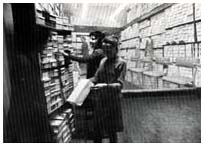 Now
then number six and seven the two different numbers you see look. That
70 48 black no cap black no cap and 70 47 that's the one the broguy one
you know what I mean yes definitely yes yea this lot here. 70 52 that's
a no cap init or is that the broguy one that's right that's a broguy one.
Oh hello have you any of those corduroy shoes size 7 or 8 or something
like that. Let's have a look for you sir. We did have a pair of these
in, but er that's a six, no there's an 8 in. Are they black? We've had
such a rush on those you know since they've been in the sale. Um I don't
really like the colour of these let's see the others. Let's have a look
at the seven. That's a seven. Probably will get into a 7 actually. Yea
well that's a 7, that's the same. Are they the same colour. Yes. You haven't
got those nice lace ups. I've got this one in a 7 this is quite a nice
one. Quite nice no I'll have to have a lace up. Well I suppose a sort
of ordinary pair. They're all sixes there you see unfortunately, that's
alright thank you very much indeed. What's that you want a lace up one
don't you. Yes please. I've hat some new ones in today... They're the
new stock. They're all 20 er 5 shillings. Um yes. They're not the sale
ones you see. Thanks very much anyway. Sorry. By bye. Not that's 48 48
48 48, 48 48 52 48 that's them looks like a muck yard out there don't
it.
Now
then number six and seven the two different numbers you see look. That
70 48 black no cap black no cap and 70 47 that's the one the broguy one
you know what I mean yes definitely yes yea this lot here. 70 52 that's
a no cap init or is that the broguy one that's right that's a broguy one.
Oh hello have you any of those corduroy shoes size 7 or 8 or something
like that. Let's have a look for you sir. We did have a pair of these
in, but er that's a six, no there's an 8 in. Are they black? We've had
such a rush on those you know since they've been in the sale. Um I don't
really like the colour of these let's see the others. Let's have a look
at the seven. That's a seven. Probably will get into a 7 actually. Yea
well that's a 7, that's the same. Are they the same colour. Yes. You haven't
got those nice lace ups. I've got this one in a 7 this is quite a nice
one. Quite nice no I'll have to have a lace up. Well I suppose a sort
of ordinary pair. They're all sixes there you see unfortunately, that's
alright thank you very much indeed. What's that you want a lace up one
don't you. Yes please. I've hat some new ones in today... They're the
new stock. They're all 20 er 5 shillings. Um yes. They're not the sale
ones you see. Thanks very much anyway. Sorry. By bye. Not that's 48 48
48 48, 48 48 52 48 that's them looks like a muck yard out there don't
it.
Hairdresser Scene from Requiem performance in 'De Lantaren'
in Rotterdam, 1971.
Masked actors reproducing in real time events recorded in high speed film
on the backprojection screen behind them. The conversation was recorded
during filming.
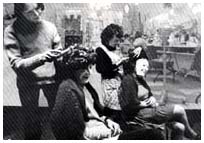 Take
all the petals down there. Um. One shampoo and soapless and give madam
a couple of new towels and take the cape off, and make sure she doesn't
get wet. Did you go to East Africa this year? Ah yes. I went to eh I went
to Mombassa last February for a fortnight. Oh lovely, for a holiday? Mm
yra honeymoon. Oh was it nice? Mm mm fabulous mm. Well these photographs
are lovely. Mmm pardon, aren't they yes really lovely. Yes, yes they are.
I feel proud of that yes, it's probably, yes it's probably only a question
o, a question of use though you know. Umm. If I'd have had the tripod
with me I'd use it but when you're travelling by air it's umm you know
you know you're limited um. Um I suppose you are. How much does it cost
yra if you want to go out and shoot say, say if you want to shoot an elephant
you probably have to pay I don't know how much, I mean I don't know oh
hu about 500 pounds for a licence. For a licence. Well the rarer the animal
the more the licence costs. I mean you get a few nice leopard skins, bring
you in about £750 each. Yes that's for the skins yes, Lord what a lot
of money. Do you think you will go there again. Mm I'd like to terribly
expensive though, yeah next time I might to for three whole weeks three,
mm yes super. Did you have to change on the flights on the way out.
Take
all the petals down there. Um. One shampoo and soapless and give madam
a couple of new towels and take the cape off, and make sure she doesn't
get wet. Did you go to East Africa this year? Ah yes. I went to eh I went
to Mombassa last February for a fortnight. Oh lovely, for a holiday? Mm
yra honeymoon. Oh was it nice? Mm mm fabulous mm. Well these photographs
are lovely. Mmm pardon, aren't they yes really lovely. Yes, yes they are.
I feel proud of that yes, it's probably, yes it's probably only a question
o, a question of use though you know. Umm. If I'd have had the tripod
with me I'd use it but when you're travelling by air it's umm you know
you know you're limited um. Um I suppose you are. How much does it cost
yra if you want to go out and shoot say, say if you want to shoot an elephant
you probably have to pay I don't know how much, I mean I don't know oh
hu about 500 pounds for a licence. For a licence. Well the rarer the animal
the more the licence costs. I mean you get a few nice leopard skins, bring
you in about £750 each. Yes that's for the skins yes, Lord what a lot
of money. Do you think you will go there again. Mm I'd like to terribly
expensive though, yeah next time I might to for three whole weeks three,
mm yes super. Did you have to change on the flights on the way out.
Graveyard Scene from Requiem performance in 'De Lantaren'
in Rotterdam, 1971.
Masked actors reproducing in real time events recorded in high speed film
on the backprojection screen behind them. The conversation was recorded
during filming.
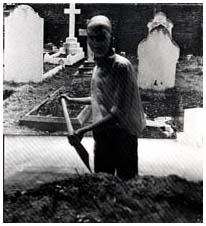 Alright now though aren't they. Interviewed for the job they are. They're
interviewed. Another good reason for getting rid of him. Who's he think
he's kidding. That was bloody ages ago though wasn't it. Well next doors
haven't moved out. Tell you what they have gone to their new address.
Not they wasn't married. No well they had the property. She'll be lucky.
What's this fucking hole. First pair that lived down that street was darkies.
They've been there. They stayed ten years. Yeah. Never mind it did they.
They said they was nice people living in that street and they was really
enjoyable with people. Ah that was then. That was then yearh. It was then.
Got the wind up. Yeah got the wind up. How long have you lived there.
Only been up there 6 months like. Bet you've been up there longer than
that. But my misses says is that your girlfriend, are you married. She
says you don't ask questions like that. Christ that one you was talking
about you know what you said lives just down the road from you. I mean
makes you bloody wonder doesn't it. I mean God knows how many you know,
you know blokes I see out with Angela. Sent old Monty Modlin round there
for a pin she wouldn't know what to bloody say. She wouldn't know what
to say I should simply say I should, you take it from me, now look here
Monty my boy, you wouldn't have a bloody corporation like that if you
had my job. You know Harry Secombe and Ted Ray, yeah who was that bloody
Dickie Henderson that's it. They were all right in their day you know.
In their heighday. Once he was a bloody marvellous man mind you I prefer
Dickie Henderson as a man but I don't care much for his act. Really, really
don't you care for Harry Secombe. No I never have, never. Then there's
old Spike Milligan. Yeah. Won't recognise him. Look at him, you take Dickie
Henderson with his bloody elephant now I ask you the show's a fucking
circus much in it years by four tune boys. Oh well I don't like it.
Alright now though aren't they. Interviewed for the job they are. They're
interviewed. Another good reason for getting rid of him. Who's he think
he's kidding. That was bloody ages ago though wasn't it. Well next doors
haven't moved out. Tell you what they have gone to their new address.
Not they wasn't married. No well they had the property. She'll be lucky.
What's this fucking hole. First pair that lived down that street was darkies.
They've been there. They stayed ten years. Yeah. Never mind it did they.
They said they was nice people living in that street and they was really
enjoyable with people. Ah that was then. That was then yearh. It was then.
Got the wind up. Yeah got the wind up. How long have you lived there.
Only been up there 6 months like. Bet you've been up there longer than
that. But my misses says is that your girlfriend, are you married. She
says you don't ask questions like that. Christ that one you was talking
about you know what you said lives just down the road from you. I mean
makes you bloody wonder doesn't it. I mean God knows how many you know,
you know blokes I see out with Angela. Sent old Monty Modlin round there
for a pin she wouldn't know what to bloody say. She wouldn't know what
to say I should simply say I should, you take it from me, now look here
Monty my boy, you wouldn't have a bloody corporation like that if you
had my job. You know Harry Secombe and Ted Ray, yeah who was that bloody
Dickie Henderson that's it. They were all right in their day you know.
In their heighday. Once he was a bloody marvellous man mind you I prefer
Dickie Henderson as a man but I don't care much for his act. Really, really
don't you care for Harry Secombe. No I never have, never. Then there's
old Spike Milligan. Yeah. Won't recognise him. Look at him, you take Dickie
Henderson with his bloody elephant now I ask you the show's a fucking
circus much in it years by four tune boys. Oh well I don't like it.
So far, there has been no second performance of the Requiem. After 1971,
Boyle stopped giving his public performances, his light shows, and his
Son et Lumiere programmes. Correspondingly, he reduced his Sensual Laboratory,
in which various friends had originally worked, to just his family.
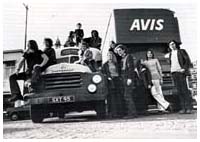 'It
is marvellous for us, as Cameron and Sebastian and Georgia grew older,
to find them becoming involved with this work. Making these pieces has
always been extremely arduous but somehow in their company, with a constant
flow of ribald banter, it's easier to ignore your blisters and your bleeding
finger nails. Increasingly we listened to their opinions and eventually
we formed a kind of partnership, sharing the labour and the rewards. I
had always received immense pleasure and satisfaction from working with
my darling colleague Joan Hills and this has increased with the participation
of our children.'[65]
'It
is marvellous for us, as Cameron and Sebastian and Georgia grew older,
to find them becoming involved with this work. Making these pieces has
always been extremely arduous but somehow in their company, with a constant
flow of ribald banter, it's easier to ignore your blisters and your bleeding
finger nails. Increasingly we listened to their opinions and eventually
we formed a kind of partnership, sharing the labour and the rewards. I
had always received immense pleasure and satisfaction from working with
my darling colleague Joan Hills and this has increased with the participation
of our children.'[65]
Since 1971 Boyle has shown mainly all kinds of surface studies. They dominated
the exhibitions of his work held in Scandinavia, Germany and Great Britain.
However, his Journey to the Surface of the Earth and his presentation
of the Multi Human Being still occupy their central place. Although he
has only been able to realise a few fragments of the actual project since
it took on its definitive form around 1970, he has been working on it
continuously. He hopes that at a certain moment there will be adequate
financial means and technical facilities to embark on this World Series
and carry it out on the universal scale he conceived for it. But until
that becomes possible, he continues to work with great intensity on preliminary
studies for all of its facets. In long series of studies he has been refining
and improving his technique and seeking solutions for the many problems
he could encounter on his exploratory journey.
Rock Series 1971-73
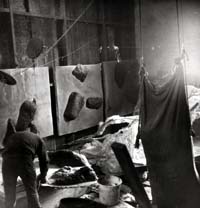 "As
it was originally planned the Rock Series was supposed to be a series
of studies of rocks and sand at regular intervals between the high and
low water mark on a rocky beach in the West Highlands of Scotland. The
pieces show these basalt rocks with shellfish and so on, and the sand
is marked with the traces of the animal life at various levels of the
beach. The series was never completed and now consists of 6 studies.'[66]
"As
it was originally planned the Rock Series was supposed to be a series
of studies of rocks and sand at regular intervals between the high and
low water mark on a rocky beach in the West Highlands of Scotland. The
pieces show these basalt rocks with shellfish and so on, and the sand
is marked with the traces of the animal life at various levels of the
beach. The series was never completed and now consists of 6 studies.'[66]
Left: Mark Boyle working on the rock series in a barn in the west of Scotland
Thaw Series 1972
"By the time we had reached the Vesterlan, a small group of islands in
the Arctic Ocean off Norway's northwest coast, slightly warmer weather
had arrived with the gulf stream. For some time we had been in the habit
of coming down to the sea's edge each night to make our camps as it was
several degrees warmer by the water than it was even only a mile inland.
It was still 15¡ or 16¡ every night. Now we were at the water's edge all
the time and the Spring was coming in like the tide. Already it remained
quite light round the clock and the spectacular sunsets reclined on the
horizon all night long without changing position much, to become in the
morning spectacular sunrises. The whole island was melting. Snow and ice
were pouring and crashing off this weird landscape. We made a Thaw Series
as the elemental part of the World Series piece. At First we wanted to
record the changes on one square of snow as it melted. But we knew that
making the first piece would so affect the underlying snow that any subsequent
piece would merely be a study of the marks made by making the first piece.
So we chose a strip of snow that was melting fast and we marked a series
of squares at regular intervals along the length of it. Then we decided
to make a piece every day, starting with a square of plain snow continuing
as the snow receded and the earth emerged, until we reached a square of
plain earth. This took five days.'
Excavation of urban refuse-fire site 1972/73
'At the end of our garden there was a small hill of ashes. All the garden
refuse was burnt on this site. When there was an interruption to the refuse
collection service all the household rubbish was burnt on it. The people
who lived in the flat below us told us it had been the rubbish dump for
10 years. First we made a study of the surface of the fire. Then we made
three vertical sections one at the edge, one half way and another across
the centre of the fire. These vertical sections showed extremely delicate
strata lines. The leaves that had been burnt showed black strata lines.
So each autumn was clearly defined. In between lodge among the garden
ash were a large number of fragments of household pottery, nails, toy
cars, piano wires, milk bottle tops, bricks, flower pots, etc.'
"NOTHING IS MORE RADICAL THAN THE FACTS'
(part of a lecture first given at Newcastle University 1972)
'A rock singer I knew once told me he had been writing poems on a Greek
island that were so esoteric that no one would ever understand them but
himself. And then one day he had decided that it was absurd, in the mid
1960's, that he should be doing anything so purpose-less, socially. And
he decided to write for the people. And he did. He wrote songs that were
banal and stupid.
This is one of the places where elitism and populism meet. There is a
certain kind of elitist populist who believes that in order to write for
the people you have to write songs that are stupid. I believe that it
you're going "to work for the people" in this or any other field you have
to work to the highest standard you are capable of. If the people do you
the honor of being interested, then you have to take the greatest care
of all, because it is so easy to assume that public approval is the final
arbiter, when in fact the only arbiter of a work of art is the artist
or the group of artists involved. Whatever the field he chooses, whether
it's Sound of Visual or Tactile or Verbal, he must explore his chosen
area to the maximum of his potential. It could be colour, or mass, or
proportion, that he was dealing with. It might be light or representation
or fantasy. It might be concepts or mathematical form, or the mechanics
of art production, distribution and exchange. Whatever his chosen area,
he must put aside everything else in his determination to explore it.
He has to immerse himself totally. He has to realise that working for
the people in this way he has to forget about working for the people.
He has to forget about doing anyone any good. The only thing he has to
do is to pursue his own goal determinedly, savagely, relentlessly on and
on and on. There is no happy ending. He never gets there. He goes on and
on and on. But sometimes instead of relentless pursing his course the
artist listens too the managers and the dealers who say, this is the next
thing that's going to be big and the public, or such and such is coming
back, or to the critics and promoters, who are almost always writing about
themselves anyway, trying to give themselves the ultimate puff, or to
the politicians and social commentators and moral rearmers who to a man
know what the public needs, what the public wants, what is good for the
public. Then you get the fashion parade. The perfectly modulated and marketable
personalised response of the artist to the current fad. The annual exhibition
of beautifully calculated developments, or always identifiable variations
on the artist's trade mark.
Down through the centuries, the people have permitted certain individuals
to be free from productive labour in order to explore, almost as their
representatives, certain areas of sensibility. If these "representatives"
fail to explore their area to the limits of their potential, or report
back, not what they actually found, but what they or their managers calculate
will go down well with the public, or what they think it is good for the
public to hear, and if they imagine that they or anybody else is capable
of deciding what it is good for the people to hear, then they are not
representatives of the people but parasites, not working for the people,
but exploiting them.'
Skin Series 1973
'For some time we had been working on a method for applying the procedures
we were using on the earth to the surface of the human body. And we had
discovered a method of chemically freezing the top layer of the epidermis
and removing it in a transparent block. Then we used the actual skin like
a negative, as a master in the enlarger, from which we made large prints.
We called these cytograms. The Skin Series was a series of cytograms made
at sites randomly selected from a crude outline diagram of M. Boyle's
body seen from all sides. There were 10 locations. It was clearly a continuation
of the programme of body pieces begun in 1966 with bodily fluids and functions
and continuing with body work in 1969.'
Lorrypark Series 1974
'At about this time in trying to get access to a particular private site
M. Boyle asked permission to take photographs. The owner asked him if
he was a professional photographer. Thinking it was the only way to get
access to the site M. Boyle said he was. The owner of the site then said
he needed some photos for a planning enquiry that he had to attend. He
explained that he was trying to get permission to turn the site into a
lorrypark and needed to prove that there was a need for a lorrypark in
the vicinity. He needed photos of lorries parked illegally at night in
the area. M. Boyle had no alternative but to agree. Unfortunately he had
never taken night photos before and didn't know how to use flash. So using
available light and extremely long exposures in the dim streets he made
a set of pictures. In some of these, because they were 2 or 3 minute exposures,
you could see buses and other vehicles having to stop and start several
times to get past the parked lorries. These apparently enabled the owner
to get his planning permission, and he in turn gave M. Boyle permission
to work on the site whenever they were not too busy. This gave us the
opportunity to work freely on a wide range of studies, variegated earth,
rubble, cracked earth, wet, moist, damp and dry mud, animal and bird footprints,
and so on. As time went by these were grouped together as the Lorrypark
Series.'
Liverpool Series 1976
'At Xmas 1975 we left our flat and got a new place. Freedom from a whole
lot of pressures and restraints led to a flood of new work in 1976. We
had been making the preparatory studies for some time for a series commissioned
by Peter Moores' Foundation in Liverpool. We had decided on a random series
based on Liverpool Docks. There were sites on the earth and in the sea.
The sea pieces were recorded on film. The whole series was first exhibited
at the Walker Art Gallery in Liverpool in a show called Real Life organised
by Edward Lucie Smith and produced by Peter Moores' in 1977.'
Concrete Pavement Series 1976
'A series of studies made along the length of a stretch of concrete pavement.
This series was not systematic. Like all of the studies we were making
at this time we were continually trying to make one that was very good.
Each time we made one we made discoveries that we thought would show us
how to do it better the next time and so we went on. But this was the
way we had always worked anyway.'
Red Causeway Series 1976
'A series of randomly selected pieces we made at regular intervals along
a raised road leading to a partially demolished factory in West London.
The road was made of red cobbles. There were cobbled pavements on either
side with a stone kerb. The first study at the top was littered with smashed
slate from the roof of the factory. The road was deserted. There was a
heatwave. We worked in the sun from sunrise till sunset. We were deliriously
happy, 10 studies each 6'x 6'.'
Breakers Yard Series 1976
'At another part of the industrial hinterland of West London we suddenly
discovered a huge slab of shattered concrete that must have been the base
of some factory machinery. It was divided into three squares, each a little
over 6 feet. These were a few inches apart. The whole area had been used
as a yard for breaking up old cars. The concrete squares were littered
with the glass from broken wind-screens. An ancient and decaying jacket
lay on one square, another was shattered, and so on. We made the three
squares and called them Breakers Yard Series.'
Red Wall Series 1976
'A series of squares randomly selected from the inside and outside of
a brick shed. We made a plan/diagram showing all the surfaces of the shed
including walls, floor, and roof, and made random selections of six foot
squares. Further selections were made to avoid overlaps, because otherwise,
where the overlap occurred, we would be recording, not how the shed actually
was, but how the shed had been affected by our making the previous study.'
Rock and Scree Series 1977
'A series of three studies made on a rock face in the western highlands
of Scotland. Rock faces, broken rock rubble, the roots of heather and
grass. In a way we were interested in what happened when you could see
how it went on beyond the edge of one of our squares. So we made three
adjacent squares about 12 inches apart. They were first exhibited at the
Felicity Samuel Gallery in 1977 and you could see the way the rock structures
moved across from one to the other.'
Railway Series 1977
'A series of randomly selected squares made along the length of a stretch
of railway line (work in progress).'
Surface and Undersurface 1977
'This was a pair piece concerning a york stone pavement. We raised one
stone from the irregular pavement, and laid it face down on the other
stones. We made a study of this piece, showing the earth that had been
underneath the stone we had raised and the sand and concrete that had
been used in levelling it. You can also see the pattern of sand still
clinging to the back of the stone. After we had completed the first study
we lifted all the other stones taking care to avoid damaging the earth
underneath more than we could help. You could see the trail of worms and
so on in the earth and the pattern of the earth and concrete that had
filled the cracks between the stones. The rectangle of earth that lay
underneath the original stone that we raised has been altered by the process
of making the first piece of the pair.'
Multi Human Being Studies 1970-1978
'In 1970 we began a series of attempts to record and fix the movement
of people in certain social situations. We made photographic exposures
for periods from a few minutes to half an hour on a variety of locations,
the entrance to a tube station, a road crossing, telephone kiosk, a children's
playground, and so on. It took us 6 to 7 years to complete the processing,
but eventually we succeeded in producing density photos which indicate
by colour differentiation the degrees of concentration of the people who
pass.
Various World Series Pieces 1970-1978
'When we left The Hague we drove straight to our site, Nyord in Denmark.
This site was a ploughed field on a small island. The elemental part of
this piece we decided was to concern the tide. The island stood in a shallow
part of the Baltic. There was very little tidal variation. We made a study
of the seabed close to the island and we made measurements throughout
24 hours and decided we would have a pump that maintained the level of
the water during a 24 hour cycle at exactly the depth it was throughout
that day. This was never completed. We made maps showing the social organisation
of the island and a study of the agricultural system, which was stripe
farming, each farm having strips of land all over the island, so that
no farmer had better land than his neighbour and each farmer also had
a strip of the orchard, a strip by the harbour, and a strip of the marsh
area. The piece was exhibited in Copenhagen, Oct. 1970, and was eventually
acquired by the museum at Krefeld.'
'We made 4 pieces of the World Series in our tour of Norway in 1972. One
was a snow piece in a forest near Elverum, then we made a second snow
piece in the Jottenheimen mountains at the top of the Ostre Slidre Valley,
then we made a tree piece in a forest at Skarberget, and finally an arctic
moss piece in the Vesteralen. With the snow pieces we felt that the pieces
themselves were the elemental pieces for those locations. In the Vesteralen
we made the Thaw Series as the elemental pieces and at Skarberget we made
a tape recording for the elemental project of the beginning of the thaw
with thunders of ice and rock collapsing from the overhanging mountains
and crashing into the forest. We did the social aspects with photographs,
returning the following summer to make the social pieces for the Jottenheimen
mountains site, as I had to leave in a big hurry that winter on account
of an outbreak of snow. All of these pieces were made in circumstances
of considerable difficulty. These pieces were exhibited and acquired by
the Henie-Onstad Museum in Oslo in 1972.'
'In 1974 we went to our site at Bergheim near Cologne. This turned out
to be an amazing open cast coal mine. It had changed considerably since
the time that the maps had been made and had moved many miles north engulfing
agricultural land on its way and landscaping what it left behind. Our
location was among the mountains and valleys of clay and slurry discarded
in the process of finding the coal. These extended for 20 or 30 miles.
The picture turned out to be a clay piece with particles of brown coal
in it. For the environmental studies we made pieces of the effects of
wind, sun and water on the different earths from the various strata of
this vast mine. We made a piece on the strata below our location, and
electronmicrophotos of the minute animal life we found there, cytograms
of the plants, recordings of the sounds and so on.'
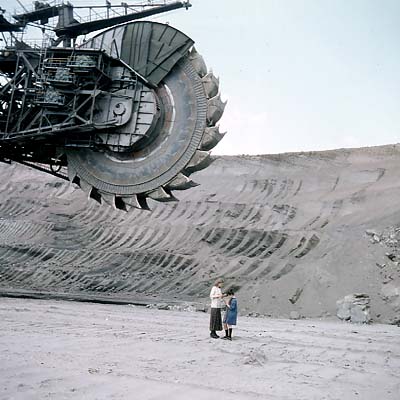
Joan Hills and Georgia at Bergheim mine, Germany, 1974